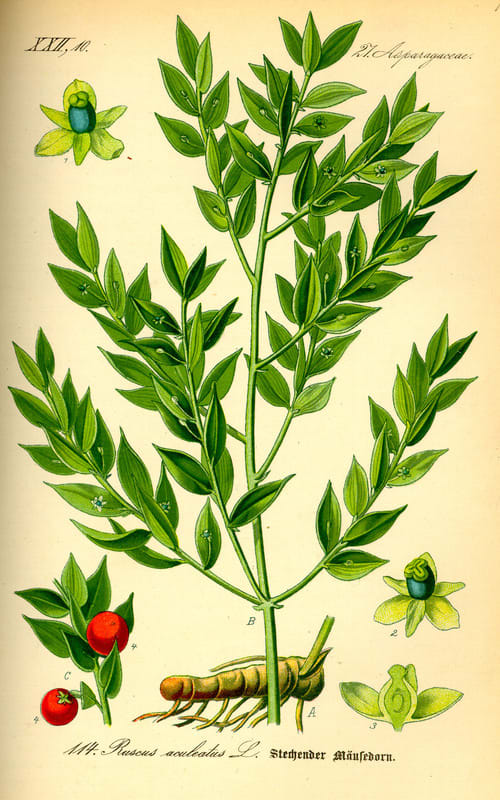
🌿 Morphology
🌞 Growing conditions
🌍 Origin and family
🌾 Uses
Warning: Despite the care taken in writing this sheet, it is essential to cross-reference sources before using or consuming any plant. When in doubt, consult a qualified professional
Permaculture uses
Butcher's Broom has limited but interesting permaculture applications. The young shoots can be eaten cooked, similar to asparagus, though they can be quite bitter. It's primarily used as an ornamental plant in shady areas and as a deterrent due to its spiky foliage. Medicinally, it's used to treat circulatory problems and hemorrhoids; however, its medicinal uses should be approached with caution and professional advice.
Permapeople description
Butcher's Broom is a small evergreen shrub native to Europe and parts of Asia. It typically grows to a height of 1-3 feet and has stiff, spiny stems. The plant produces small, greenish-white flowers in the winter, followed by bright red berries. It prefers well-drained soil and partial to full shade. Butcher's Broom is commonly used in ornamental gardens and as a decorative plant for the holidays. It has also been used in traditional medicine for its diuretic and anti-inflammatory properties.
Botanical description
Ruscus aculeatus, commonly known as Butcher's Broom, is a small evergreen shrub in the family Asparagaceae. It's native to Eurasia and parts of North Africa. It typically grows to a height of 0.5 to 1 meter. The 'leaves' are actually flattened stems called cladodes, which are dark green and leathery, with a sharp spine at the tip. Small, inconspicuous greenish-white flowers appear in the center of the cladodes. Female plants produce bright red berries in the winter, which are persistent and add to the plant's ornamental value. It is dioecious, meaning male and female flowers are on separate plants. It thrives in dry, shaded woodlands.
Companion planting
Butcher's Broom thrives in shady conditions, making it a good companion for plants that prefer similar environments. It can be planted under trees or alongside other shade-loving shrubs like ferns, hostas, and rhododendrons. Its deterrent qualities may offer some protection to nearby plants from certain pests, although specific companion planting interactions are not well-documented.
Propagation methods
Butcher's Broom can be propagated by seed, division, or semi-hardwood cuttings. Seed propagation is slow and requires stratification. Division of established clumps is a more reliable method. Cuttings can be taken in late summer or early autumn and rooted in a well-draining medium.
History and traditions
Butcher's Broom has a long history of traditional use. The name 'Butcher's Broom' comes from its historical use by butchers to clean their chopping blocks, as the stiff branches were effective at scrubbing. It has also been used medicinally for centuries, particularly for its purported venotonic properties. In some cultures, it was believed to ward off evil spirits.
Usage calendar
Flowering occurs in winter and spring (January-April). Berries ripen in autumn and persist through winter. Planting is best done in autumn or spring. Pruning is generally not necessary, but can be done in late winter to remove dead or damaged branches.
